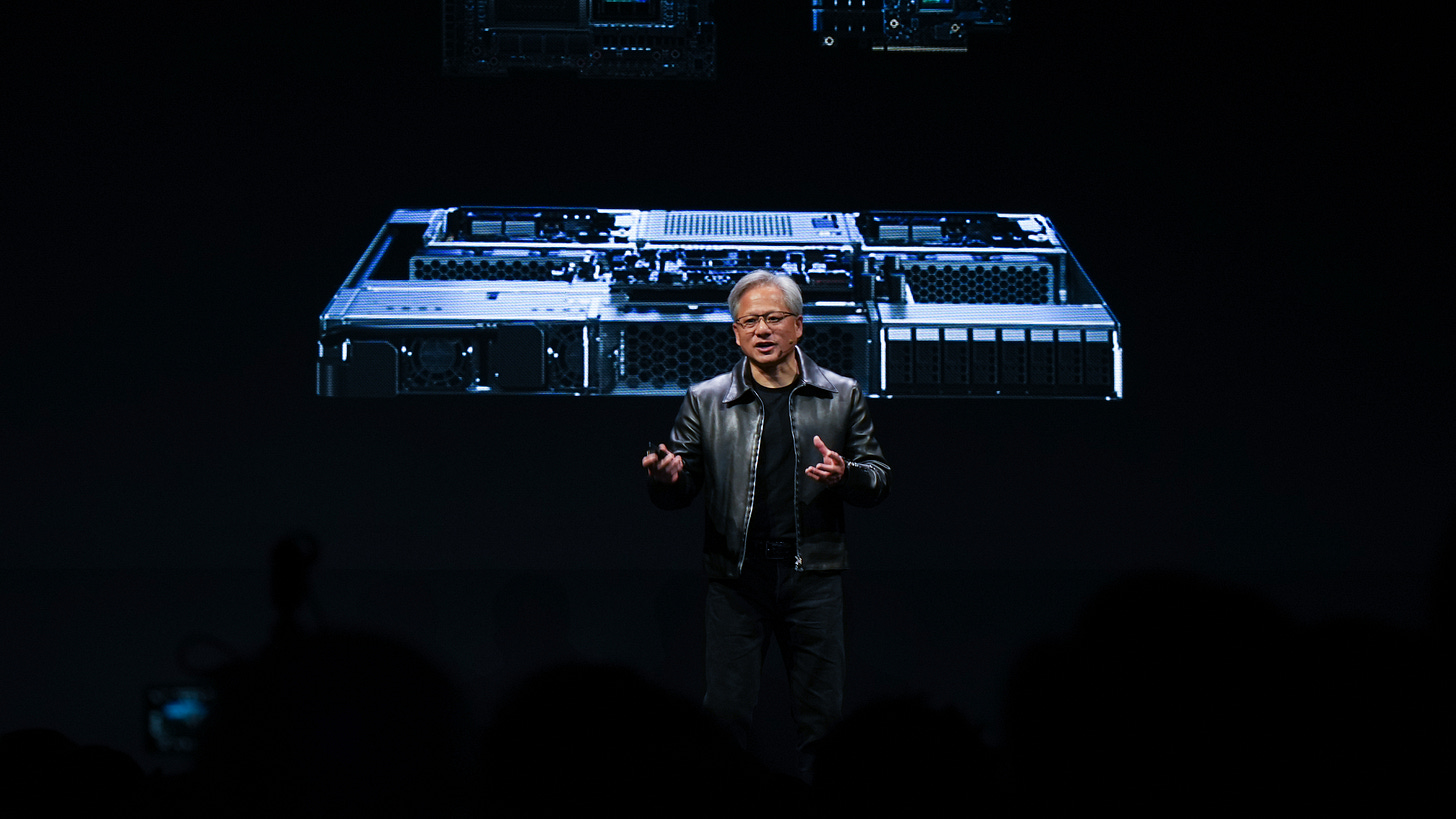Riding on the Shoulders of Giants
$1T Market Cap, The AI Extinction Statement, No Copywrite Protection, Build your own ChatGPT & more.
Greetings everyone,
👋 Deiniol here.
$1,000,000,000,000 - that is how much Nvidia is now worth (give or take).
What’s more, if you had invested $20,000 into Nvidia in early 2015, it would now be worth ~$1,654,000. Damn, missed that one.
Here is your weekly dose of AI broken down into 3 highlights, 2 tools and 1 demo/tutorial.
Please feel free to share with your closest. Hope you enjoy 🦘
"AI has reinvented computing from the ground up. In every way, this is a rebirth of the computer industry."
- Jensen Huang | CEO NVIDIA
1 - NVIDIA
On the Shoulders of Giants

Nvidia’s market capitalization crossed the significant $1T threshold this week, briefly rubbing shoulders with an exclusive club of trillion-dollar American entities including Apple, Amazon, Alphabet, and Microsoft. Its graphics processing units (GPUs) are indispensable for AI & ML computations. Plus, Nvidia expects its second-quarter revenue to rocket to $11 billion, up from $7.19 billion.
As we know from Google I/O and MSFT Build, Sundar and Satya have immense plans ahead to continue incorporating AI into the majority of their tools. Couple this with every person and their dog wanting a piece of the Ai-ction, and an IP like no other, Nvidia is riding on the shoulders of giants.
🖥 Main takeaways from COMPUTEX 2023
Nvidia's Grace Hopper GH200 "superchips" are now in full production, combining the flagship Hopper H100 GPUs and Grace CPUs to handle diverse computational tasks. Nvidia has linked 256 of these GH200 chips using its NVLink networking technology to create a supercomputer for training large language models and complex algorithms, with Microsoft, Google and Meta as the first customers. The memory of this supercomputer? Not much… Just 144 terabytes.
The GeForce RTX 4060 Ti GPU, a GPU designed for gamers, is now in full production, being manufactured in large quantities with partners in Taiwan.
Nvidia launched the Avatar Cloud Engine (ACE) for Games, a service that provides pre-trained AI models for game developers to enhance the character of non-playable characters (NPCs) through AI-powered language interactions.
The Nvidia Cuda computing model serves four million developers and over 3,000 applications. It has seen 40 million downloads, 25 million of which occurred last year alone.
TLDR; Nvidia has incredible market advantages and diversity within both hardware and software. However, with Taiwan’s political situation uncertain, Japanese chip manufacturing (as noted in section 1) may prove a worthy competitor.
Watch Jensen’s keynote here.
2 - All Chips on the Table
Japan: Copyright Laws don’t apply to AI training
The Japanese government is ditching copyright enforcement for data in AI training. Yup, you read that right - Japanese AI now has the green light to use ANY data, whether it's for -profit, non-profit, or even from the dark corners of the web.
But, not everyone's thrilled about it. Some Anime artists and graphic creators are crying foul, fearing the devaluation of their labour of love. On the flip side, academia and business sectors are rallying for AI, seeing it as leverage to push Japan onto the global AI throne.
Rapidus Corp, a Japanese semiconductor manufacturer established in August 2022 with the support of eight major Japanese companies including SoftBank and SONY, is gradually stepping into the spotlight as a serious contender in the world of AI chips.
TLDR; This maneuver adds a fresh chapter to the global regulatory debate. Coupled with their dedication to compete in the world of AI chips, Japan's commitment to play in the AI game is clear. Expect quick and robust development from Japan.
3 - The AI Extinction Statement
The Center for AI Safety released a statement on the risk of human extinction from AI
An SF-based non-profit group, the Centre for AI Safety, has dropped a statement that has been legitimately signed by some very notable figures and AI Scientists. It's not a lengthy manifesto, no committees, no pauses - just a single line that punches right to the heart of the matter:
Signatories include:
Geoffrey Hinton -Emeritus Professor of Computer Science, University of Toronto
Yoshua Bengio- Professor of Computer Science, U. Montreal / Mila
Demis Hassabis - CEO, Google DeepMind
Sam Altman - CEO, OpenAI
Dario Amodei - CEO, Anthropic
Dawn Song - Professor of Computer Science, UC Berkeley
Emad Mostaque - CEO, Stability AI
Ian Goodfellow - Principal Scientist, Google DeepMind
Grimes - Musician / Artist
And many more. It’ll be interesting to see where this leads.
🛠 Tool 1
EdApp | AI CreateCreate courses in a click of a button – no brainstorm, research, or strike of inspiration necessary.
The tool is designed with contemporary learning strategies and trends at its core. I built a course to test it out and it was remarkable how fast, accurate and interactive the course was. 90% of the course was ready for launch. This is clearly advantageous for instructional designers as it enables them to deliver professionally designed, snackable workplace learning that their teams will value.
Oh yeh, create an unlimited number of lessons and access their editable course library for free.
🛠 Tool 2
OpenChat | Build your own ChatGPTHere in Australia, our Government is light years behind in most things. Us entrepreneurs take advantage of this by implementing somewhat commonplace software and systems that aren’t generally publicised. Consider it software arbitrage.
The facilities that OpenChat provides would be stupidly popular in many Australian industries. The majority of Small-Medium Businesses have heard of ChatGPT but not many realise they can implement their own version based on their own data, on their own website.
OpenChat operates by using efficient crawlers to scan provided data, such as website content or PDF files and then transform it into knowledge using Large Language Models (LLMs).
With OpenChat, you can create a range of AI applications including:
Customer support chatbots trained on your specific data.
A private tutor bot that answers questions based on uploaded books.
An internal knowledge bot to save employees time searching for information.
Private chatbots to share with clients.
Personal library bots that can answer questions based on uploaded books and texts.
🧑🏫 Demo/Tutorial
How Diffusion Models Work | DeepLearning.AIAnother gem by Andrew Ng and Sharon Zhou.
Learn the technical details of how diffusion models - which power Midjourney, DALL·E 2 and Stable Diffusion - work. At the end of the course, you will have a model that can serve as a starting point for your own exploration of diffusion models for your applications. You’ll also end up with working code to generate your own video game sprites in Jupyter!
Whist knowledge of Python, Tensorflow or Pytorch will help you get the most out of this course, those without knowledge can still learn a lot.
If you found value in this week’s newsletter, please support us by sharing with your closest and liking our publication at the bottom. It helps a lot 🤗
Until next week, earthlings, bots and cyborgs, code out!
Deiniol 🇦🇺
Something exclusively for you guys:
Use the code AISUITE for 10% off all plans.
🏆 We got codesnippets.ai 28 new subscribers in just a few hours:
Get your business, podcast or AI Art in front of thousands of email subscribers, Twitter followers and AI enthusiasts, startup founders, aspiring entrepreneurs and artificial intelligence students who visit our website frequently.






